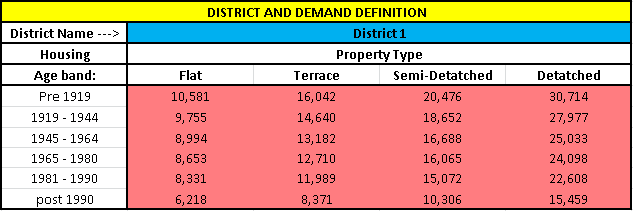Methodology
Our project evaluated the different configurations studied within the context of three main areas: economic, environmental and efficiency. Within these areas we identified particular criteria which a developer would want to consider when making a decision about which system performed best:
- Economic
- Capital, running and maintenance costs
- End user costs
- Subsidies and Potential Incomes
- Technical
- Energy Efficiency
- Exergy
- Environmental
- Impacts
- Emissions
To make a reliable evaluation we had to create a base case with which to calculate our criteria from. We chose a district size of 200 homes because this is a typical size that you would deploy CHP for so makes an obvious starting point for study. We used an energy model to calculate the energy requirements for the community using census data on heating energy requirements.
For the new build case, we used typical new build energy demand data which accounts for the higher levels of insulation in buildings.
For the retrofit case we made sure that the energy demand accounted for the age of the houses. We used census data on what the percentages were on the age of houses across the UK to create a realistic energy demand.
For both the new build and retrofit cases we made sure the district contained a spread of dwelling types: flats, terraced, semi-detached and detached reflective of the census data.
We created an Excel document to generate the yearly demand. The figures below show some screenshots and explanations of this process.

Figure 1. Red area contains yearly energy demand (kWh/year) based on the age and type of dwelling.

Figure 2. From the census data we produced percentages reflective of the current housing stock within the UK. We used our 200 housing base case to determine the numbers of type and age of housing. Note: for new build the age was always post 1990.
Combing the data from figure 1 and figure 2 we get our yearly demands:
Retrofit - 3,288,915 kWh/year
New Build - 2,061,582 kWh/year
After we had our demand we began evaluating the other criteria. The process and results of each can be found by navigating the tabs at the top of the page.
Once we had all of our results we pulled them together we presented them on a table using a 1-10 scale. Click on the "Results" tab at the top of this page to view our findings.
In order to gauge the importance of all these different criteria, we consulted a focus group...
Focus Group
To choose the way in which these criteria were weighted, we asked a focus group, made up of 15 of our peers with a good understanding of the issues surrounding the topic of district heating, to rank the criteria from most to least important. From this we gave each metric a percentage score to weight it. The survey asked the following:
"We want you to assess these criteria as if you are looking to establish and run a district heating scheme for an area. Remember that although you are not looking at it from a consumer point of view the public are unlikely to take an option that represents a raw deal for them just because it suits you as a decision maker.
Criteria Description:
Cost - The amount of money needed to install and run the system you as a council or housing business would have to pay.
Energy Efficiency - The basic efficiency of the components in the system you are thinking of buying.
Exergetic Efficiency - Using the 2nd law of thermodynamics exergy looks irreversibility instead of inefficiency. The more irreversibility, the more entropy- which cannot be reused as energy. If you aren't sure about this metric, we recommend ranking it similarly to energy efficiency.
Emissions - The amount of greenhouse gas emissions your system will produce.
Impacts - A qualitative measure. Consider things like disruption during construction/deconstruction; Any exhaust fumes in the local area from a boiler house; being responsible for the maintenance of what would previously have been independent people's heating systems. From a user point of view controllability and independence are maybe an issue.
End User Costs - You may be looking at this from the perspective of a manager, but would you compensate on another part of the criteria to make it cheaper for your constituents/clients?
Income/Subsidies - How much do government subsides (which change all the time and are hard to predict or depend on) matter in your decision making? In the longer term, once you have paid back your investment, how much does profit matter to you? NOTE: Income represents any additional income over and above what you would make normally in the cost category i.e. selling electricity from CHP, ash for fertiliser etc."
